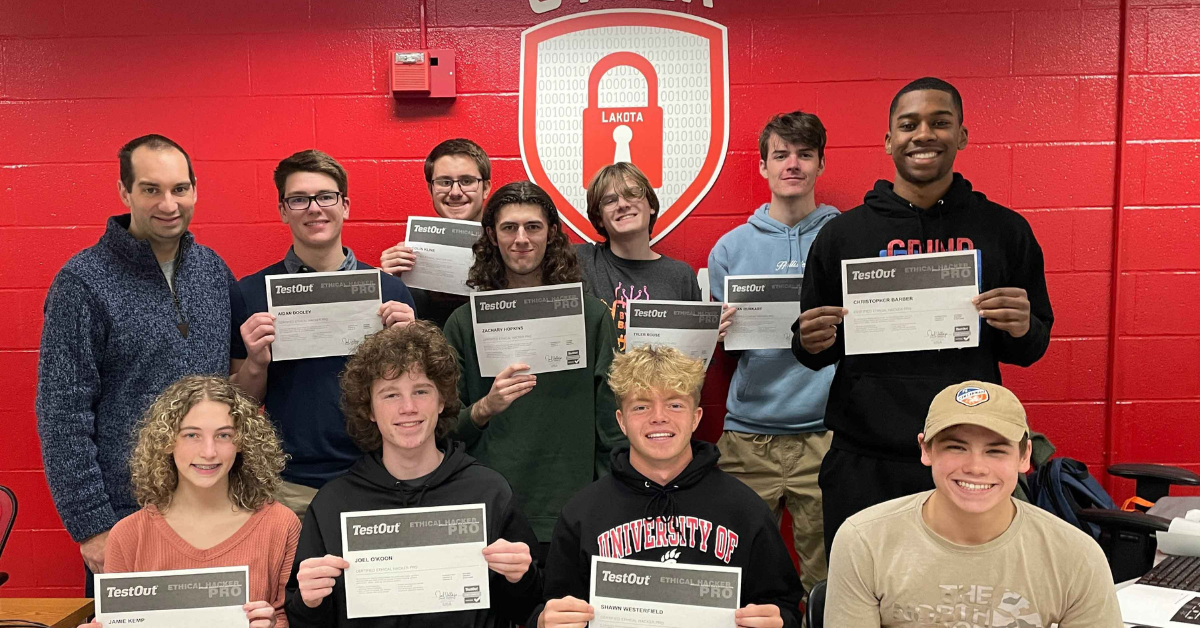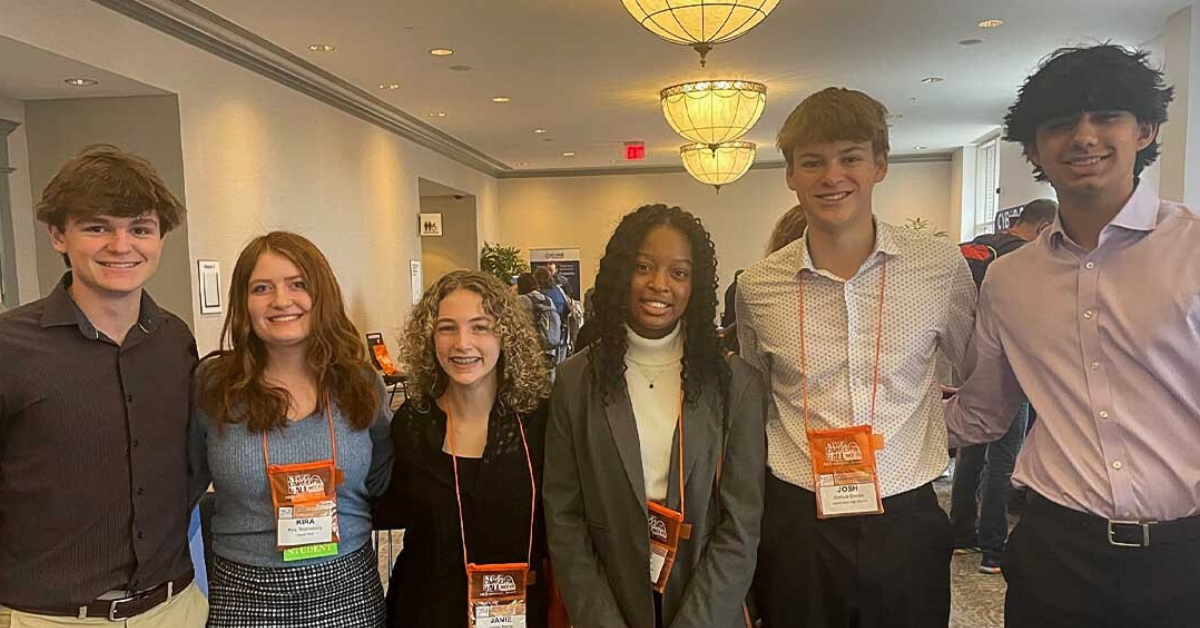
Feb 17, 2023 1:45:00 PM
Cincinnati native Zoey Chappell first heard about her high school’s new cybersecurity program as a 15-year-old, when she says she was not even old enough to be consistently checking her email, let alone stop hackers. She tried out the class after not loving her other STEM electives, but with no knowledge of the topic — and that was OK.
She’s now one of the 85% of Lakota Cyber Academy students who complete the three-year career prep program and go on to a career in the field. Not only is she majoring in the subject at Rochester Institute of Technology in New York, but her knowledge and the certification the high school program gave her provided the means to start making money right away.
While her friends are working on-campus jobs for minimum wage, she’s a part-time employee in cybersecurity with US Bank, with a high likelihood of a job at the same company on graduation. She’s entering a field that has an anticipated 3.5 million openings by 2025, CyberCrime magazine reports.
The Cyber Academy is offered at three levels, Cybersecurity I through III, to sophomores through seniors, at the two high schools in one of the state’s top ten largest school districts, Lakota Local Schools. Students in the class learn about social engineering, such as recognizing phishing emails, being an ethical cybersecurity professional and more. And they are proving their mettle nationally.
The high schoolers beat out 95% of college participants in National Cyber Week, and placed first in the high school competition. Teacher Ben Dougherty was named one of two recipients of the 2022 Presidential Cybersecurity Education Award by the U.S. Department of Education, for raising the bar in how students prepare for rewarding careers in the field. Teacher Moriah Walker has spoken at multiple conferences about the program, and is planning a STEM evening for middle school students to see how high school girls are making waves as women in an underrepresented field.
These educators’ efforts to move students toward a career-ready position in a highly sought-after field, and to recruit a wide diversity of students, have their peers around the country turning heads. Here’s why it’s working.

Just as many adults don’t know much about cybersecurity, 15-year-olds in high school might not have any background knowledge of the subject. That’s to be expected in this program, where Chappell says the initial lessons have much more to do with puzzles requiring logic than IP addresses.
“There are no prerequisites. That’s one of the things that we’ve done to try to make this open to a broader swath of students. There are no prerequisite math or engineering or computer science courses. Anyone can take this,” Dougherty says.
Between both high schools, around 270 students will participate in the program next year, around a 50% enrollment increase.
When novice students like Chappell hear the potential of six-figure salaries, it sparks their interest. “I was like, that sounds like something I should try,” she laughs.
It’s unlikely most districts have a cybersecurity expert with a teaching license in hand, just waiting to start a program. But what they might have is someone like Lakota’s Ben Dougherty, a teacher with some experience and willingness to learn.
Dougherty had developed a cryptography unit for his math class, as an application hook to get students interested in inverse functions, he says, and had given conference talks in using that engaging tactic. Since the program's launch, he has taken additional courses to add a computer science endorsement to his license.
Once you have one teacher like that, others will follow. “You don’t need to have that stuff to get started —Moriah’s a great example, “ Dougherty says. “You just need someone who is a lifelong learner who has passion, who’s willing to just jump in and learn things as they go with students. You can grab anyone who knows how to teach.”
If you want to progress on to create higher level classes and compete nationally, it can help to learn more, though, he adds.
There was no curriculum in the beginning. The teachers built it from the ground up, with some support from a local college. Walker adds that cyber.org is an excellent resource, along with Ring. She explains that only 1% of U.S. schools have this type of curriculum implemented, so for most schools, just the intro class would be a good start.
Lakota’s program pairs students with a mentor in the field, and frequently has guest speakers from well-known companies come speak to students, and collaborate. Chappell still talks to her mentor today, asking questions as she navigates real career issues in her job. She also distinctly remembers a high-level, female cybersecurity expert speaking to her class.
Fewer than a quarter of cybersecurity professionals are female, ISC reports. Now, due to intentional recruiting, Lakota’s program has improved its ratio —next year around 24% of students are female.
But the road for girls and women in cybersecurity still has its share of bumps. When Chappell was in her second year of the program, she was the only female student.While in high school, Chappell started a school chapter of Women In Computer Science (WICS) to help more female students interested in STEM careers connect.
But classes were still tough socially. She remembers sitting by herself, though she had multiple friends in the class, and that she began to navigate “microaggressions” from male classmates that she attributes to being the only female.
This is still something she battles in her college classes. “A friend above me in cyber started dumbing things down. I had to sit there and go, ‘Dude, I have my security plus [certification] and I work part-time, I’ve done three years of cyber. If you tell me one more time what an IP address is, I’m going to…,’”Chappell says.
“I’ve noticed I’m having to find really sly ways to slide in my qualifications.”
Adolph Brown is a psychologist, speaker, former educator and host of the “The Parent Test” on ABC who advises companies and schools on best diversity, equity and inclusion plans. He explains that there are multiple steps high school programs can take to focus on recruitment and retention of female, Black, and Brown students.
“We’re talking about being focused, clear, and purposeful in our approach…If we’re going to diversify any industry, you have to bring beneficial new skill sets and ways of thinking to the table.”
For others hoping to recruit a diverse student population into a STEM program, he recommends:
Chappell hopes others have the benefit of a Lakota-style cybersecurity program in Ohio and across the country, especially when she’s working in her dorm room in pajamas on projects she loves, with a bright future in cybersecurity ahead of her. She refuses to be deterred by naysayers.
“The spite of trying to prove [myself] to people is kind of rewarding,” she says. “ I like what I’m doing, and I’m good at what I’m doing, and if I have to spite a couple men along the way that don’t believe that, then OK.”
Alexandra Frost is a Cincinnati-based freelance journalist, content marketing writer, copywriter, and editor focusing on health and wellness, parenting, real estate, business, education, and lifestyle. Away from the keyboard, Alex is also mom to her four sons under age 7, who keep things chaotic, fun, and interesting. For over a decade she has been helping publications and companies connect with readers and bring high-quality information and research to them in a relatable voice. She has been published in the Washington Post, Huffington Post, Glamour, Shape, Today's Parent, Reader's Digest, Parents, Women's Health, and Insider. Alex has a Master of Arts in Teaching, and a Bachelor of Arts in Mass Communications/Journalism, both from Miami University. She has also taught high school for 10 years, specializing in media education. To read more of her work or to connect, check out her website or her social media on Twitter, Instagram, or Linked In.
Few issues in education spark more tension and debate than standardized testing. Are they a tool for equity or a burden on students? A necessary check on school systems or a flawed measure of...
Charter schools are public schools with a purpose. Operating independently from traditional school districts, they're tuition-free, open to all students, and publicly funded—but with more flexibility...
Despite the benefits of a diverse teaching force, prospective teachers of color fall out of our leaky preparation pipeline at every stage: preparation, hiring, induction, and retention. Here’s what...
Ed Post is the flagship website platform of brightbeam, a 501(c3) network of education activists and influencers demanding a better education and a brighter future for every child.
© 2020-2025 brightbeam. All rights reserved.
Leave a Comment